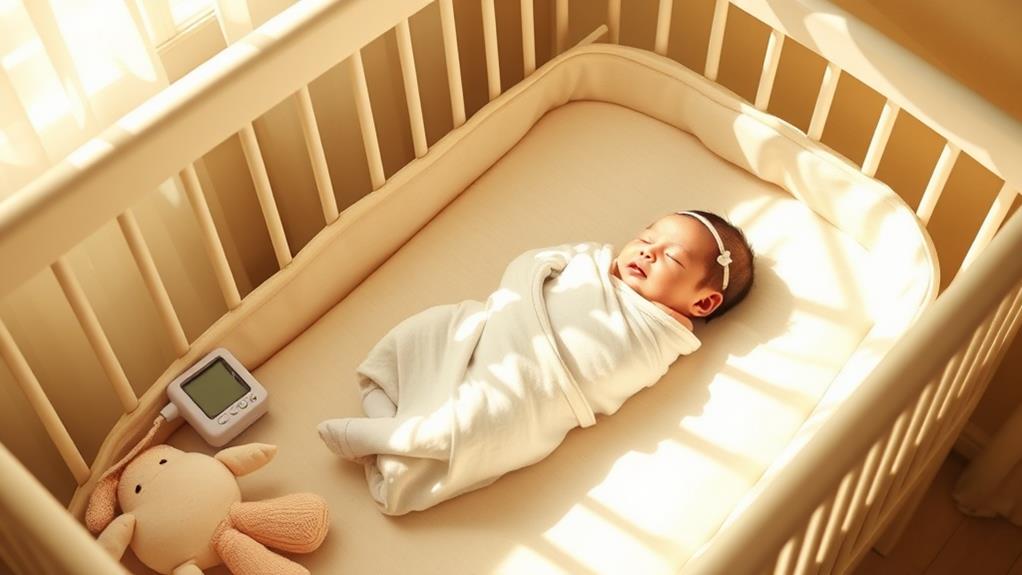When you bring your newborn home, it's crucial to keep an eye out for signs of jaundice, which can appear as a yellow tint on their skin or eyes. You might notice changes in your baby's feeding habits or alertness, and these can be key indicators of how they're doing. Understanding what to monitor and knowing how to prevent jaundice can make a significant difference. But what happens if you miss the early signs? You'll want to know the steps you can take to ensure your baby's health remains a top priority.
Understanding Newborn Jaundice

Newborn jaundice often pops up in the first few days of life, and it's important to understand what's happening in your baby's body. Essentially, this condition occurs when there's too much bilirubin in your baby's bloodstream. Bilirubin is a yellow substance created when the body breaks down red blood cells.
In newborns, their livers may not be fully developed, making it harder to process this bilirubin efficiently. You might notice a yellow tint on your baby's skin or the whites of their eyes, which is a key sign of jaundice.
While it can sound alarming, most cases are mild and resolve on their own as your baby's liver matures. It's also common for breastfeeding babies to experience jaundice, especially if they're not getting enough milk in those early days.
Monitoring your baby's feeding and the number of wet diapers can help gauge their health. If you're concerned about jaundice or notice worsening symptoms, reach out to your pediatrician.
They can provide guidance and support, ensuring your little one gets the care they need. Understanding jaundice helps you feel more empowered as a parent, making it easier to navigate these early months.
Causes of Jaundice in Infants
Understanding the causes of jaundice in infants is crucial for parents navigating this common condition. Jaundice happens when there's a buildup of bilirubin, a yellow substance produced during the breakdown of red blood cells.
In newborns, this can occur for a few reasons. Firstly, your baby's liver mightn't be mature enough to process bilirubin efficiently. This is particularly common in premature infants, whose livers are still developing.
Another cause could be related to blood type incompatibility. If your blood type differs from your baby's, it can lead to a faster breakdown of red blood cells, increasing bilirubin levels.
Additionally, bruising during birth can cause an excess of red blood cells to break down, contributing to jaundice.
In some cases, breast milk jaundice can occur when substances in breast milk interfere with bilirubin processing. While this typically resolves on its own, it's essential to monitor your baby's condition.
Understanding these causes helps you recognize when to seek help. If you notice any signs of jaundice, don't hesitate to reach out to your pediatrician for guidance and support.
Symptoms to Monitor

It's essential to keep an eye out for specific symptoms that may indicate jaundice in your baby. One of the first signs you'll likely notice is a yellow tint to your baby's skin and the whites of their eyes. This yellowing can start on the face and move down to the chest and belly. If you see this, it's important to take note of when it appears and how it progresses.
Additionally, watch for changes in your baby's feeding patterns. If they seem unusually sleepy or lethargic, or if they're having difficulty latching onto the breast or bottle, these could be warning signs.
You should also monitor their urine and stool color; jaundice can affect these as well. Typically, a healthy baby will have light yellow urine and mustard-colored stools.
If your baby's urine appears dark or their stools are pale, that could indicate a problem.
Lastly, keep track of your baby's weight. If they're not gaining weight as expected, it's worth discussing with your pediatrician.
Early detection is key, so trust your instincts and don't hesitate to reach out if you're concerned.
Diagnosis and Testing
Identifying symptoms is just the first step in managing jaundice in your baby. To confirm the diagnosis, your pediatrician will typically perform a physical examination. They'll check for yellowing in your baby's skin and eyes, which is where jaundice usually shows up first.
If they suspect jaundice, they may recommend a blood test to measure the bilirubin levels in your baby's bloodstream. This test is crucial because it helps determine the severity of jaundice.
If bilirubin levels are high, your pediatrician might suggest additional testing to identify the underlying cause. For instance, they may check for conditions like blood type incompatibility or liver issues.
Sometimes, a non-invasive device called a transcutaneous bilirubinometer is used to measure bilirubin levels without drawing blood. This can make the process less stressful for both you and your baby.
Treatment Options Available

When jaundice shows up in your newborn, several treatment options are available to help bring bilirubin levels down to a safe range. The most common approach is phototherapy, where your baby is placed under special lights that help break down the bilirubin in their skin. This treatment is usually effective and painless, making it a popular choice.
If the jaundice is more severe, your doctor might recommend a blood transfusion. This option is less common but can quickly lower bilirubin levels by replacing the infant's blood with fresh donor blood. It's essential to discuss the benefits and risks with your healthcare provider.
In some cases, increasing your newborn's feedings can also help. Whether you're breastfeeding or using formula, feeding your baby more frequently can encourage bowel movements, which helps eliminate excess bilirubin from their system.
Your doctor will monitor your baby's progress closely, adjusting treatments as needed.
Prevention Strategies for Parents
Preventing newborn jaundice requires proactive steps from parents right from the beginning. One of the best things you can do is ensure your baby feeds regularly, whether you choose breastfeeding or formula feeding. Frequent feedings help flush out bilirubin from your baby's system, reducing the risk of jaundice.
Next, keep an eye on your baby's hydration. Proper hydration supports overall health and helps prevent jaundice. If you're breastfeeding, aim for at least 8 to 12 feedings a day during the first few weeks. If you're using formula, follow the guidelines for your baby's age and weight.
It's also important to monitor your baby's skin color. If you notice any yellowing, especially on the face or eyes, take action.
Lastly, talk to your healthcare provider about any family history of jaundice or other conditions that may affect your baby. They can offer tailored advice and support.
When to Seek Medical Help

It's crucial to recognize the signs that warrant medical attention for newborn jaundice. If you notice your baby's skin or the whites of their eyes turning yellow, especially if it seems to worsen, it's time to act. While some jaundice is common in newborns, sudden changes can indicate a more serious issue.
Keep an eye out for other symptoms, too. If your baby is very lethargic, isn't feeding well, or seems unusually fussy, those could be warning signs.
Moreover, if jaundice appears within the first 24 hours after birth, you should definitely consult a doctor, as this can indicate a more urgent condition.
You'll also want to seek help if the jaundice lasts longer than two weeks for a breastfed baby or one week for a formula-fed baby. Your healthcare provider can evaluate the situation and determine if treatment is necessary.
